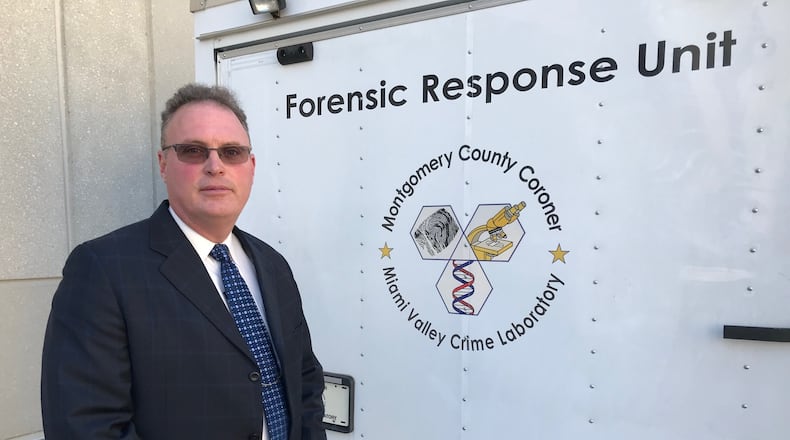“We are so far from the end of the epidemic, but we are perhaps at the end of the beginning,” Azar said at a health care event sponsored by the Milken Institute think tank.
Montgomery County Coroner Kent Harshbarger said the Dayton area’s death numbers mirrored the national slowdown until just the past few months.
“The last three months we’ve started to climb in overdose deaths again in our metropolitan area… particularly the last month and a half we’ve seen a spike in fentanyl analogue deaths,” Harshbarger said.
Preliminary numbers for August and September show 30 and 28 overdose deaths respectively, which is up from an average of 21 per month the first half of the year.
RELATED: What Ohio did with the feds’ $26M for addiction treatment
The Support for Patients and Communities Act will increase the nation’s treatment and recovery housing capacity, train more doctors to treat addiction and get the U.S. Postal Service to screen overseas packages for fentanyl, an opioid synthetic that has fueled the increase in overdose deaths.
Confronting the opioid epidemic has been the rare issue uniting Republicans and Democrats.
Sen. Rob Portman, R-Ohio, who attended the signing ceremony, and Sen. Sherrod Brown, D-Ohio, had major roles in writing the bill.
Portman added the measure that would make it more difficult for drug traffickers to ship synthetic drugs such as fentanyl through the U.S. mail. Brown wrote a section to recognize residential pediatric recovery facilities as providers under Medicaid so that babies born with neonatal abstinence syndrome can recover in the best setting for them and their families.
RELATED: 3 ways the Dayton VA is fighting the opioid crisis
“Today’s bill signing is a major victory for Ohio and for the country, and it marks a significant step forward in our efforts to turn the tide of addiction,” Portman said.
Brown said he was proud that he and Portman were “able to work together to get significant, bipartisan legislation signed into law to stop dangerous drugs at the border and keep them out of Ohio communities.”
At the ceremony, Trump cited Portman, saying he wanted to thank him “for working to ensure that the bill gives law enforcement the tools and resources they need to stop ultra-lethal – think about that word, ultra-lethal, that’s a big statement – drugs like fentanyl from being trafficked throughout our mail.”
The legislation also lifts a Medicaid exclusion that prevented residential treatment facilities from having more than 16 beds.
Portman called the exclusion “an arcane, decades-old policy that is preventing more Americans from getting the treatment they need. I thank the president for his support throughout this process, and I’m proud that these landmark opioid reforms are now the law of the land.”
RELATED: $71.5M in federal funds coming to Ohio for opioid crisis
Azar said the slowdown in overdose deaths since mid-2017 is attributable to the multi-pronged approach federal, state and local officials have taken, including an increase in treatment with medications such as buprenorphine and naltrexone. Medication-assisted treatment has proven to be effective, he said, when used alongside counseling and ongoing support.
He also noted much broader access to the overdose-reversing drug naloxone, and a documented decline in the number of people misusing prescription opioids as doctors take greater care in prescribing.
Harshbarger attributed the decline in deaths that began in the middle of 2017 to a number of factors, including a decline in the supply of fentanyl analogues like carfentanil.
“From November or December of 2016 through May of 2017, the numbers were unheard of anywhere in the country really,” he said. “We weren’t prepared to handle that. The resources were overwhelmed, personnel were overwhelmed.”
“We still saw fentanyl, we still saw heroin, and what emerged is methamphetamine and cocaine. But the carfentanils, the really powerful drugs, were not on our streets like before.”
Montgomery County has recorded 222 overdose deaths so far in 2018, on pace to see between 260 and 300 for the year, Harshbarger said. Other urban areas in the state are seeing similar numbers, he said, while in rural areas the decline has remained steady.
“It’s still too many,” he said. “The fentanyl analogues are returning and methamphetamine and cocaine are still on our streets.”
The availability of Narcan won’t be of as much help if fentanyl analogues make a resurgence, Harshbarger said, because the drugs are too powerful.
But he’s encouraged by the progress that has been made in the community to try and reduce the number of drug users and save lives.
“There’s many more treatment options, there’s more information, there’s more support in the community,” he said.
Jack Torry of the Washington Bureau and Associated Press contributed to this story.
New challenge for recovering addicts: Finding a job
Can Dayton go from ‘overdose capital’ to a model for recovery?
‘A whole new life:’ Local people share their path out of the depths of addiction, and into long-term recovery
Mother of 7 rebuilding family after addiction
A day with Dayton’s overdose response team
How to get help: An opioid addiction resource guide
About The Path Forward
The Dayton Daily News has assembled a team to seek solutions to the region’s biggest problems, including the addiction crisis, which has killed thousands, torn families apart and served as a barrier to economic progress. For past stories from The Path Forward team, go to DaytonDailyNews.com/PathForward
About the Author


